Michigan boasts a rich avian tapestry, and among its feathered residents, woodpeckers stand out as charismatic and industrious.
In this exploration, we delve into the vibrant world of Michigan’s woodpeckers, uncovering the unique characteristics of ten common species.
These avian artisans, with their distinctive drumming and striking plumage, play integral roles in the state’s ecosystems.
Each species adds a layer of diversity to Michigan’s wooded landscapes, from the iconic Pileated Woodpecker to the adaptable Downy Woodpecker.
Join us as we unravel the secrets of these common woodpeckers, shedding light on their behaviors, habitats, and the ecological significance they bring to the Great Lakes State.
Welcome to the captivating realm of the ten common woodpecker species that call Michigan home. Stay sharp.
10 Woodpeckers in Michigan
Let’s discover Michigan’s diverse world of woodpeckers, each species bringing its unique charm to the state’s woodlands.
From the iconic Pileated Woodpecker to the elusive American Three-toed Woodpecker, these avian residents contribute to the ecological tapestry of Michigan’s forests, each with distinct behaviors and roles in the ecosystem. Explore their fascinating characteristics below.
1. Pileated Woodpecker
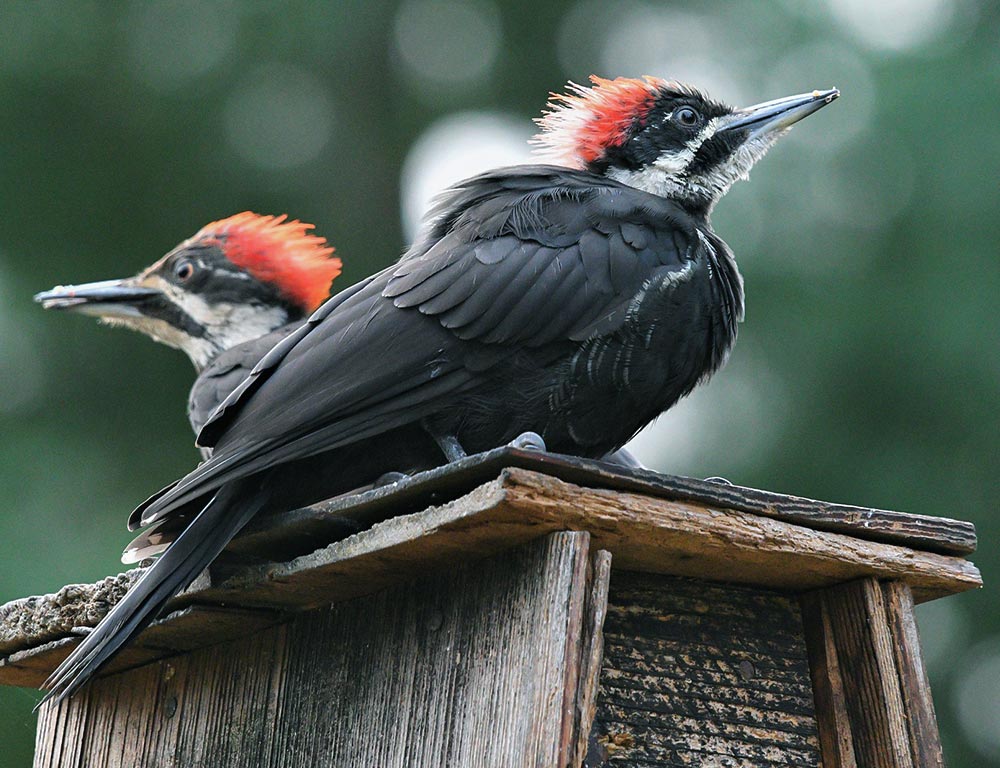
- Scientific Name: Dryocopus pileatus
- Life Span: Up to 12 years
- Size: 16-19 inches
- Weight: 8-12 ounces
- Food: Insects, especially carpenter ants and wood-boring beetle larvae
- Wingspan: 26-30 inches
- Status: Common
The Pileated Woodpecker, with its striking red crest and large size, is one of Michigan’s most impressive woodpeckers.
With a life span of up to 12 years, these birds are known for their distinctive drumming sounds and distinctive rectangular-shaped excavations in trees, marking their presence in the wooded landscapes.
Pileated woodpeckers are primarily insectivores, using their strong bills to chip away at tree bark in search of carpenter ants and beetle larvae. Their expansive wingspan of 26-30 inches aids in agile flight through the forest.
Pileated woodpeckers are often found in mature forests, establishing territories and vigorously defending them. Their drumming sounds serve as both a territorial signal and a means of communication with potential mates.
These birds are also known for their distinctive ‘wo-kik’ calls. Nesting in tree cavities, they contribute to forest ecosystems by controlling insect populations and aiding in the decomposition of dead trees.
2. Downy Woodpecker
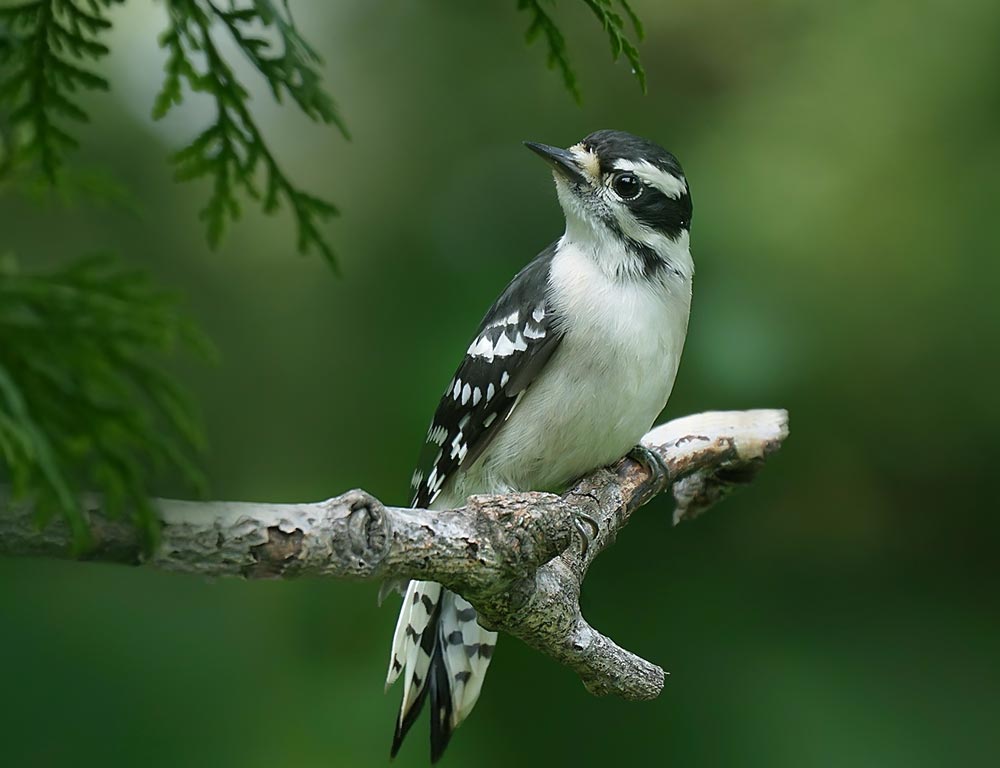
- Scientific Name: Dryobates pubescens
- Life Span: 4-6 years
- Size: 5.5-7 inches
- Weight: 0.7-1 ounce
- Food: Insects, seeds, and berries
- Wingspan: 9-12 inches
- Status: Common
The Downy Woodpecker, Michigan’s smallest woodpecker, is easily identifiable by its black and white plumage and small size.
With a life span of 4-6 years, these birds are adaptable and commonly found in various habitats, from woodlands to urban areas. Their distinctive drumming sounds and ‘pik’ calls are frequent in Michigan’s diverse landscapes.
Downy woodpeckers are versatile feeders, consuming insects, seeds, and berries. They often climb tree trunks and branches, using their specialized tongue to extract insects from crevices.
These birds are crucial in controlling insect populations and contribute to the overall health of forests and gardens.
3. Red-headed Woodpecker
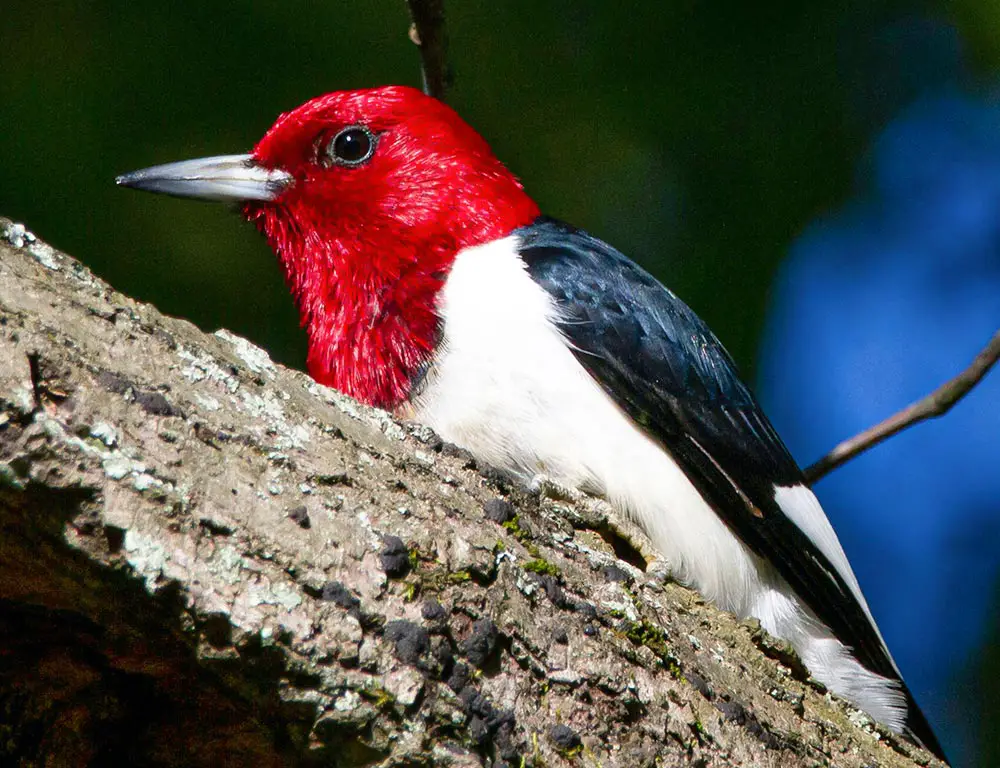
- Scientific Name: Melanerpes erythrocephalus
- Life Span: 9-12 years
- Size: 7.5-9.1 inches
- Weight: 2.2-3.2 ounces
- Food: Insects, fruits, seeds, and nuts
- Wingspan: 16.5-17.7 inches
- Status: Declining
The Red-headed Woodpecker is known for its vibrant redhead, which contrasts with its black and white body. With a life span of 9-12 years, these woodpeckers are, unfortunately, experiencing a decline in population, making them a conservation concern in Michigan.
Red-headed woodpeckers are versatile foragers, preying on insects, fruits, seeds, and nuts. They are known for their unique method of catching insects mid-air and caching surplus food by wedging it into bark crevices.
Their preference for open habitats, like savannas and open woodlands, makes them vulnerable to habitat loss. Conservation efforts are crucial to ensure the survival of this distinctive woodpecker species in Michigan.
4. Red-bellied Woodpecker
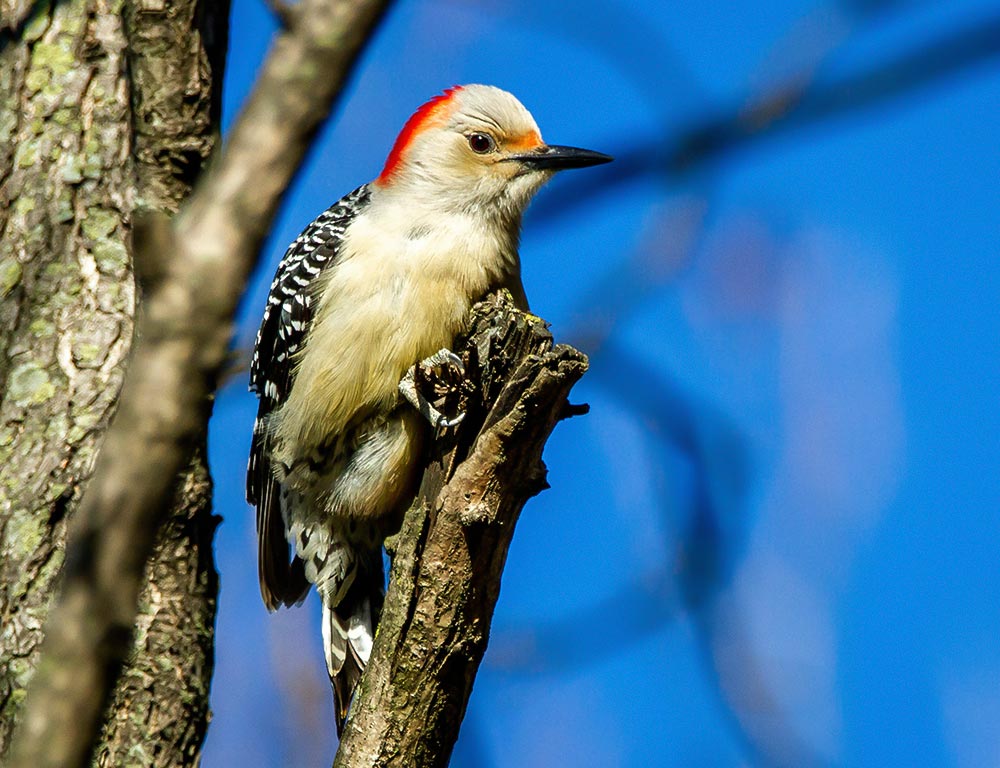
- Scientific Name: Melanerpes carolinus
- Life Span: 9-13 years
- Size: 9-10.5 inches
- Weight: 2-3.2 ounces
- Food: Insects, fruits, nuts, and seeds
- Wingspan: 13-16 inches
- Status: Common
Despite its name, the Red-bellied Woodpecker’s red crown is more noticeable than its pale red belly. These medium-sized woodpeckers are 9-13 years old and are common residents in Michigan.
Their striking black and white barred pattern, along with their distinctive calls, makes them easily recognizable.
Red-bellied woodpeckers are omnivores, feeding on various foods, including insects, fruits, nuts, and seeds. They are often seen foraging on tree trunks and branches, using their strong bills to extract insects from bark.
These adaptable birds also consume a significant amount of fruits and nuts, contributing to seed dispersal in their habitat.
5. Northern Flicker
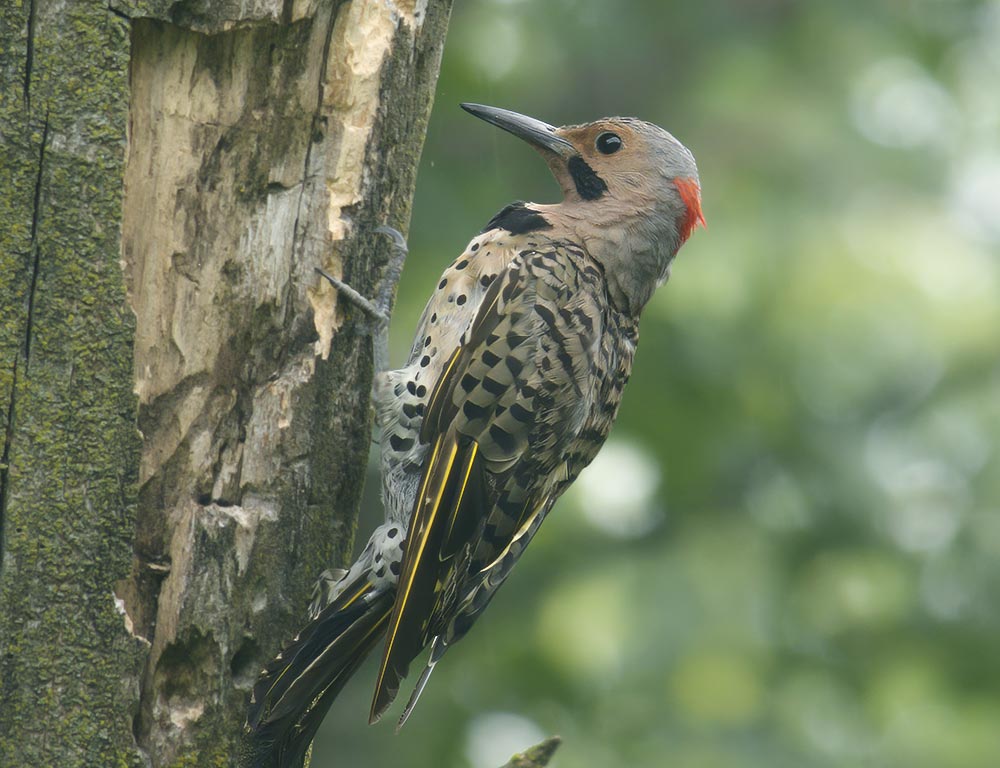
- Scientific Name: Colaptes auratus
- Life Span: 6-9 years
- Size: 11-14 inches
- Weight: 3-5.6 ounces
- Food: Insects, fruits, and seeds
- Wingspan: 16.5-20 inches
- Status: Common
The Northern Flicker is a unique woodpecker with a tan or pinkish underbelly, distinctive black markings, and a prominent black crescent on its chest.
With a life span of 6-9 years, these birds are common in Michigan, especially in open habitats. Their vibrant plumage and distinctive calls, resembling laughter, make them stand out.
Northern Flickers are ground feeders, often foraging for ants and other insects in open spaces. Their diet also includes fruits and seeds, making them versatile foragers.
They are known for their drumming sounds, which can be heard during breeding season as part of courtship displays and territory establishment.
6. Yellow-bellied Sapsucker
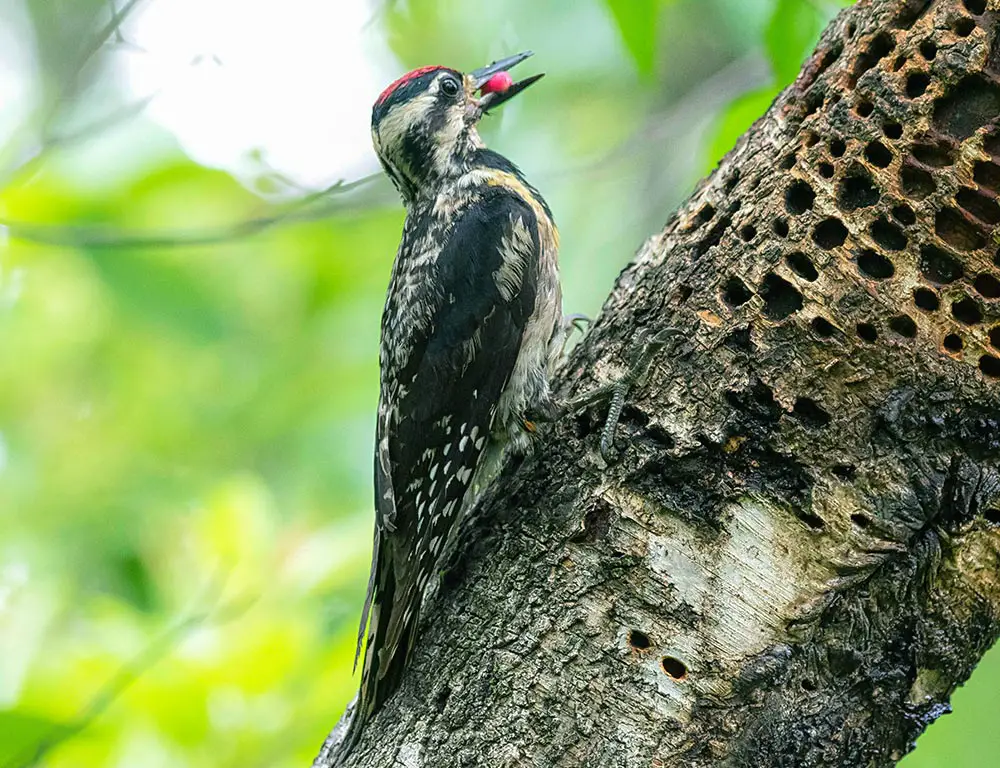
- Scientific Name: Sphyrapicus varius
- Life Span: 7-8 years
- Size: 7.5-8.7 inches
- Weight: 1.5-2.7 ounces
- Food: Sap, insects, fruits, and berries
- Wingspan: 13-17 inches
- Status: Common
The Yellow-bellied Sapsucker is named for its habit of drilling holes in trees to feed on sap.
These medium-sized woodpeckers have a life span of 7-8 years and are easily identified by their black and white plumage with a distinctive red forehead and throat.
As their name suggests, Yellow-bellied Sapsuckers feed on sap by creating small, organized holes in trees. They also consume insects attracted to the sap, fruits, and berries.
Their migratory behavior means they may only be present in Michigan during certain times of the year, as they breed in northern forests and winter in the southeastern United States and Central America.
7. Black-backed Woodpecker
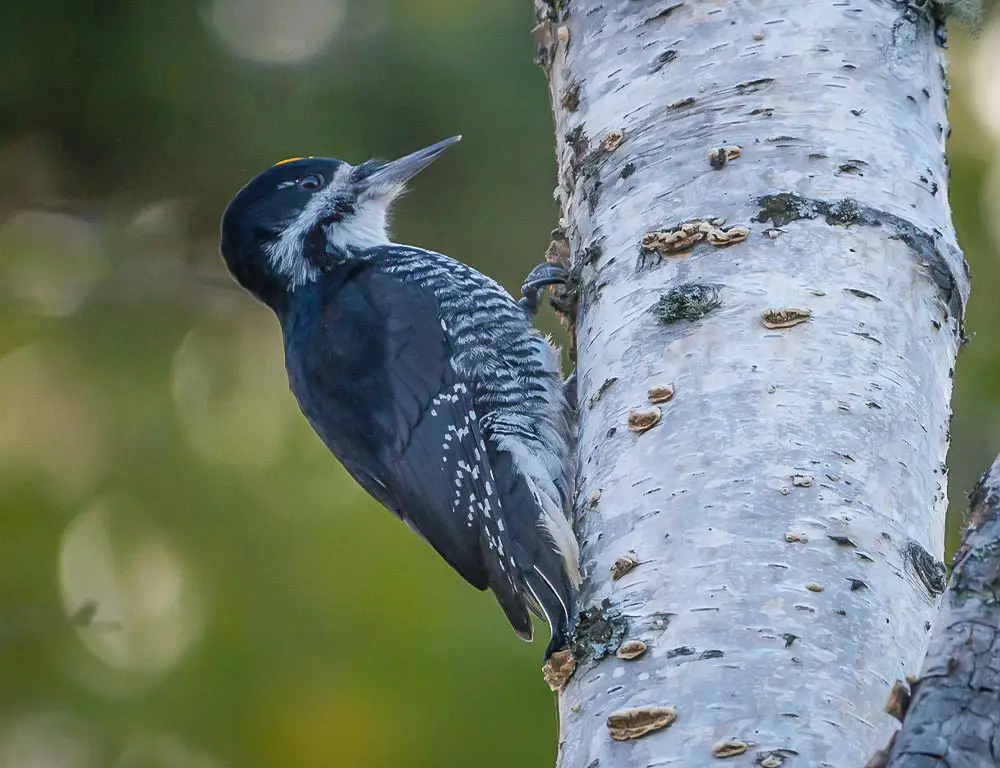
- Scientific Name: Picoides arcticus
- Life Span: 5-6 years
- Size: 9-10 inches
- Weight: 2-3.3 ounces
- Food: Insects, especially wood-boring beetles
- Wingspan: 16-18 inches
- Status: Uncommon
The Black-backed Woodpecker is a less common woodpecker in Michigan, easily recognized by its black back and white barred pattern on its face and underparts.
With a life span of 5-6 years, these birds are often associated with mature coniferous forests.
Black-backed Woodpeckers are specialized foragers, primarily feeding on wood-boring beetles and other insects found in decaying or recently burned trees.
They are well-adapted to post-fire environments, where they play a crucial role in ecosystem recovery by controlling insect infestations in fire-damaged trees.
Conservation efforts are important to protect their habitats and ensure their continued presence in Michigan.
8. American Three-toed Woodpecker
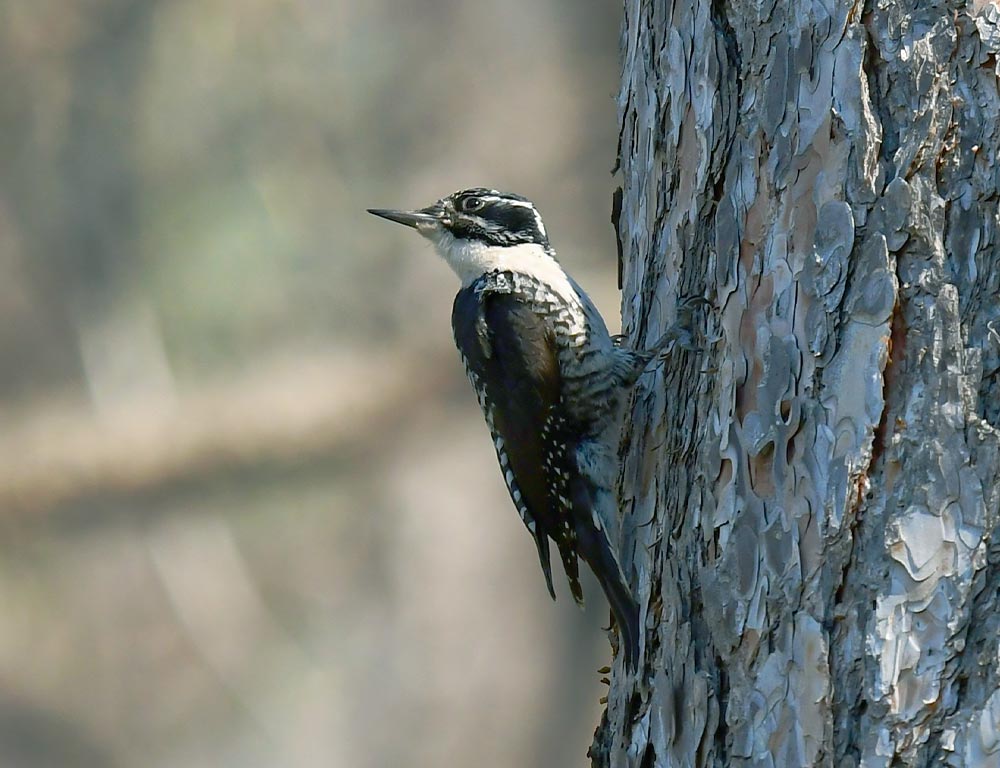
- Scientific Name: Picoides dorsalis
- Life Span: 6-10 years
- Size: 8-9 inches
- Weight: 2-3 ounces
- Food: Insects, especially wood-boring beetles
- Wingspan: 14-16 inches
- Status: Uncommon
The American Three-toed Woodpecker is known for its distinctive three-toed pattern, a unique feature among North American woodpeckers.
These medium-sized woodpeckers have a life span of 6-10 years and are typically found in coniferous forests.
Like the Black-backed Woodpecker, the American Three-toed Woodpecker specializes in foraging insects, especially wood-boring beetles, in dead or decaying trees.
They are well-adapted to bore into the bark and wood to find their prey. Their presence is often associated with forests impacted by diseases, infestations, or fires, where they contribute to the ecosystem’s health by controlling pest populations.
9. Lewis’s Woodpecker

- Scientific Name: Melanerpes lewis
- Life Span: 7-8 years
- Size: 10-11 inches
- Weight: 3-5 ounces
- Food: Insects, fruits, and nuts
- Wingspan: 18-20 inches
- Status: Uncommon
Lewis’s Woodpecker is a distinctive species with a unique coloration featuring a dark greenish-black back and a rosy pink belly.
With a life span of 7-8 years, these woodpeckers are uncommon in Michigan and are often found in open woodlands, burned areas, or riparian zones.
Unlike other woodpeckers, Lewis’s Woodpecker has a flycatcher-like foraging style. They catch insects on the wing and also feed on fruits and nuts.
Their reliance on open landscapes makes them vulnerable to habitat loss, and conservation efforts are essential to ensure their continued presence.
10. Leuconotopicus (Genus including the White-headed, Black-backed, and Red-cockaded Woodpeckers)
The genus Leuconotopicus includes several woodpecker species, each with its own characteristics. Three notable species are the White-headed Woodpecker (L. albolarvatus), Black-backed Woodpecker (L. arcticus), and Red-cockaded Woodpecker (L. borealis).
White-headed Woodpecker
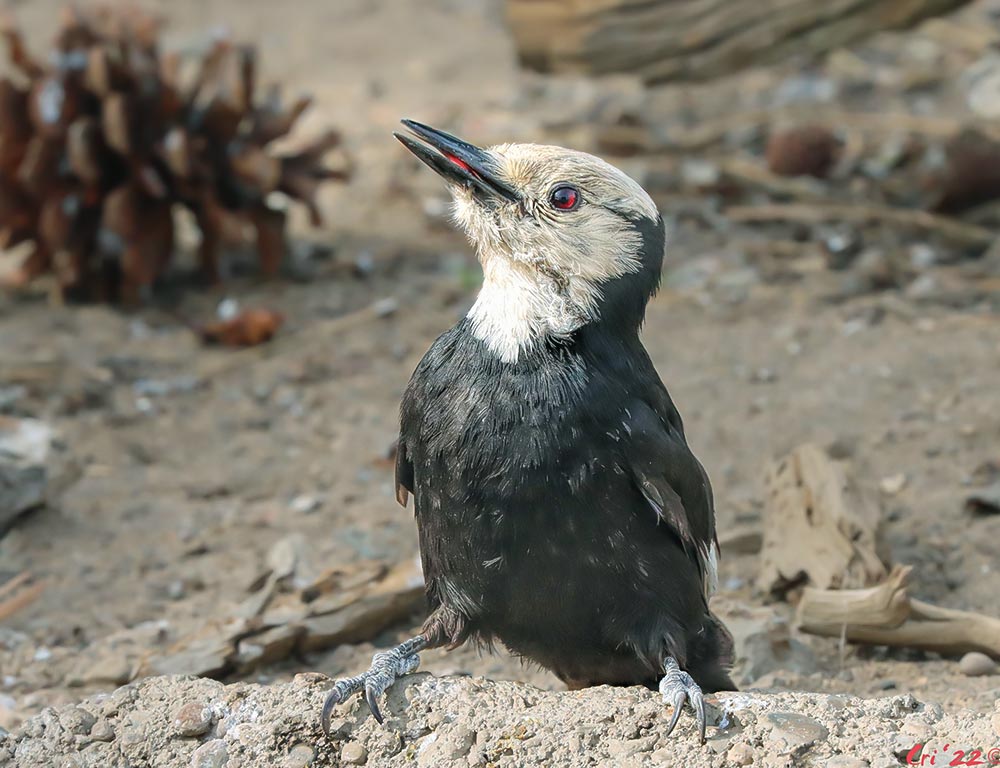
- Scientific Name: Leuconotopicus albolarvatus
- Life Span: 6-8 years
- Size: 8-10 inches
- Weight: 2-4 ounces
- Food: Insects, especially ants, and seeds
- Wingspan: 16-17 inches
- Status: Uncommon
Red-cockaded Woodpecker
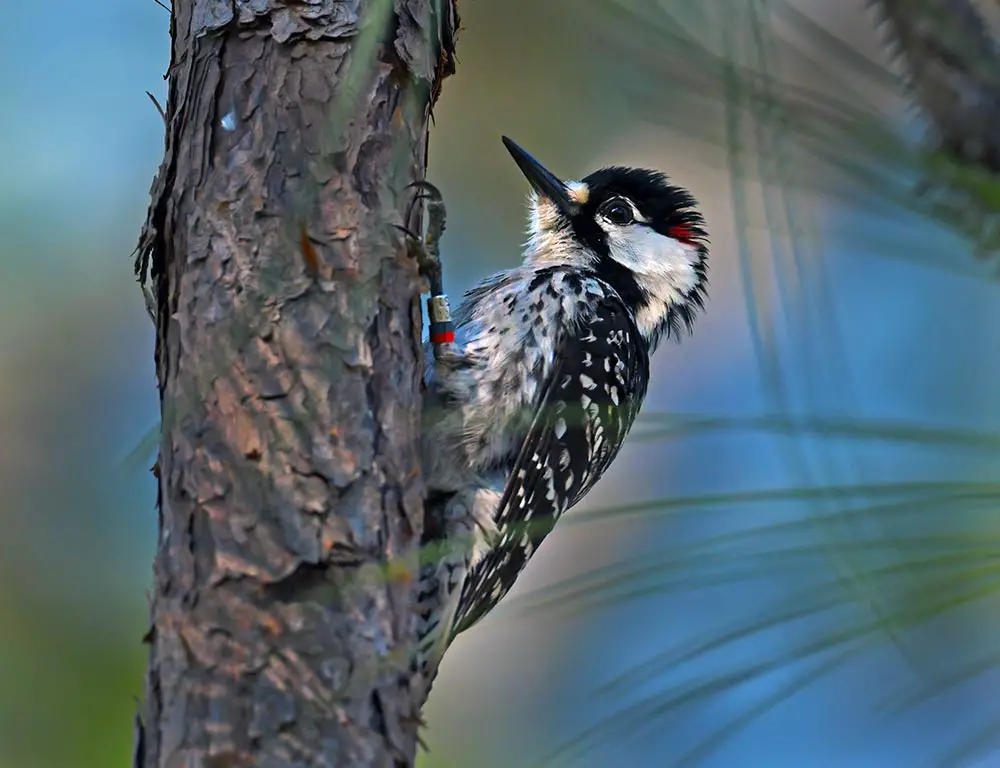
- Scientific Name: Leuconotopicus borealis
- Life Span: 4-6 years
- Size: 7-9 inches
- Weight: 1.5-2.3 ounces
- Food: Insects, especially ants, and spiders
- Wingspan: 13-16 inches
- Status: Endangered
Description (for the genus as a whole)
The Leuconotopicus genus includes woodpeckers with various characteristics, but many prefer mature or old-growth forests.
These woodpeckers often have specific habitat requirements and play essential roles in maintaining ecosystem balance through insect control and habitat modification.
Conservation efforts are vital for species within this genus, especially for those facing declining populations and endangered status.
Ecological Significance of Woodpeckers in Michigan
Woodpeckers in Michigan are crucial in maintaining ecological balance within the state’s diverse landscapes.
Beyond their distinctive drumming sounds and vibrant plumage, these avian inhabitants contribute significantly to the health and vitality of Michigan’s forests.
Here are some key points elaborating on the ecological significance of woodpeckers in the region:
Insect Population Control
Woodpeckers are efficient insect predators, targeting wood-boring beetles and other pests. Their foraging activities help control insect populations, preventing infestations that could otherwise harm trees and disrupt the ecosystem.
Habitat Modification
Woodpeckers modify tree habitats through excavation and cavity creation, providing nesting opportunities for themselves and other cavity-nesting species. This, in turn, enhances biodiversity and supports a healthier ecosystem.
Tree Health Indicators
Woodpecker activities like drilling for insects and creating cavities indicate tree health. By monitoring woodpecker behavior, researchers and conservationists can assess the overall well-being of forested areas.
Seed Dispersal
Several woodpecker species consume fruits and nuts, contributing to seed dispersal. This activity aids in regenerating plant species, promoting genetic diversity and the sustainability of forest ecosystems.
Ecosystem Recovery after Disturbances
Specialized woodpecker species, like the Black-backed Woodpecker, thrive in post-fire environments.
Their presence accelerates recovery by controlling insect infestations in fire-damaged trees, facilitating ecosystem regeneration.
Indicators of Forest Health
The presence and behavior of woodpeckers can serve as indicators of broader forest health.
Changes in woodpecker populations or behavior may signal shifts in the ecological balance, prompting conservation efforts to maintain the overall well-being of Michigan’s forests.
Wrapping Up
In the intricate tapestry of Michigan’s ecosystems, woodpeckers emerge as unsung heroes, their drumming sounds echoing the vitality they bring.
From insect control to habitat modification, these avian inhabitants play a pivotal role in sustaining the health and diversity of the state’s woodlands.
As stewards of ecological balance, woodpeckers remind us of the interconnectedness of all species, contributing to the resilience and vibrancy of Michigan’s natural landscapes.
Recognizing and safeguarding their significance is not merely an ornithological pursuit but a commitment to nurturing thriving ecosystems for future generations. Thank you very much.